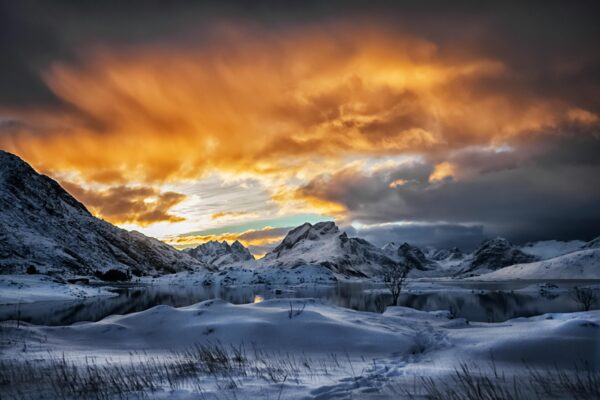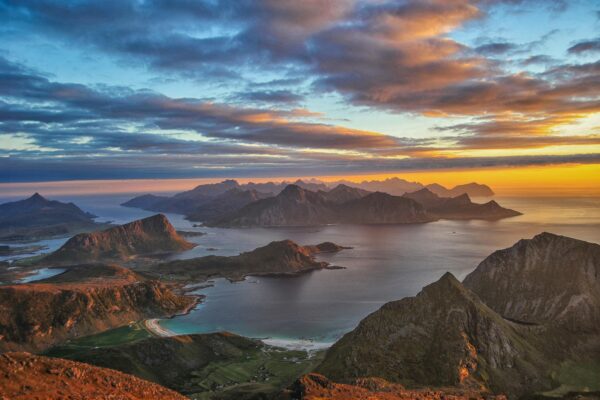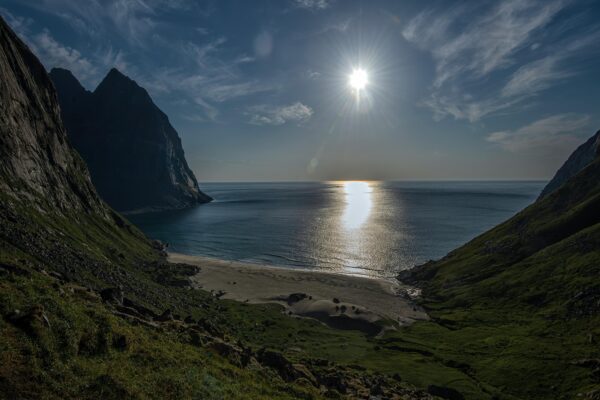Table of Contents

The term “midnight sun” refers to a natural phenomenon that occurs during the summer months in regions close to the Arctic and Antarctic Circles. It is a period when the sun remains visible at local midnight, effectively resulting in 24 hours of daylight. Norway, located well within the Arctic Circle, is one of the best destinations to witness this awe-inspiring event.
Experiencing the Arctic Circle daylight in Norway is not just about watching the sun hover on the horizon at midnight; it is about immersing oneself in a surreal landscape where time seems to stand still. The phenomenon typically occurs between late May and late July in Northern Norway, especially above the Arctic Circle in towns like Tromsø, Bodø, and the North Cape.
For those seeking a unique travel experience, the Arctic Circle daylight offers both adventure and serenity. Travelers can engage in activities like hiking, kayaking, and sightseeing, all under the golden hues of a never-setting sun. This guide explores everything you need to know about experiencing the midnight sun in Norway, from the science behind the spectacle to the best locations and activities to make the most of your visit.
The Science Behind the Midnight Sun
Understanding the polar day phenomenon starts with the Earth’s axial tilt. Earth is tilted on its axis by approximately 23.5 degrees, which means that during the summer months, the North Pole is tilted towards the sun. As a result, regions above the Arctic Circle receive continuous daylight. This unique alignment causes the sun to dip close to the horizon but never fully set, creating a perpetual twilight that can last for weeks. The closer you are to the pole, the longer the period of the midnight sun.
In places like Svalbard, Norway’s northernmost territory, the sun doesn’t set at all from late April to late August. Experiencing the midnight sun in Norway is both a scientific marvel and a spiritual encounter. The phenomenon impacts both natural ecosystems and human biology. Animals alter their behavior, and humans often experience changes in sleep patterns. Understanding this astronomical event adds a layer of depth to your journey and makes witnessing it all the more meaningful.
Whether you are a science enthusiast or a curious traveler, the midnight sun is a spectacle that challenges your perception of time and daylight. It’s not just a beautiful moment; it’s a cosmic event that reminds us of our planet’s intricate dance with the sun.

Best Places to Witness the Arctic Circle daylight in Norway
If you’re planning on experiencing the Arctic Circle daylight in Norway, location is key. While the entire northern region offers incredible views, some places are better suited due to accessibility, natural beauty, and cultural offerings. Tromsø, often referred to as the “Gateway to the Arctic,” is a popular choice. This vibrant city combines urban comforts with Arctic wilderness, making it an ideal base. Here, you can take a cable car up Mount Storsteinen for panoramic views under the polar day phenomenon. Another exceptional location is the Lofoten Islands, known for their dramatic peaks and picturesque fishing villages.
The golden light of the Arctic Circle daylight reflects off the sea and mountains, creating an almost surreal setting perfect for photography. North Cape (Nordkapp) is one of the northernmost points in Europe and offers uninterrupted views of the horizon, making it a top destination for this unique phenomenon. Alta and Bodø are also fantastic options, offering both natural landscapes and rich cultural experiences.
Each of these destinations provides a different yet equally enchanting way of experiencing the midnight sun in Norway. Choosing your destination depends on what you want out of your trip—be it solitude in nature, cultural exploration, or family-friendly activities. Regardless of where you go, witnessing the midnight sun in Norway is bound to leave you awe-inspired.
Activities to Enjoy Under the Midnight Sun
One of the most exciting parts of experiencing the polar day phenomenon in Norway is the endless array of outdoor activities you can enjoy, all under continuous daylight. This extended daylight opens up opportunities for late-night hiking, fishing, kayaking, and even golfing. Imagine teeing off at 11 p.m. or kayaking through fjords in the soft glow of a Arctic Circle daylight—it’s an experience unlike any other.
In Tromsø, guided hikes and midnight sun cruises are popular choices. These activities offer unique vantage points and memorable ways to absorb the scenery. The Lofoten Islands provide excellent terrain for hiking and photography, especially during the golden hours that last all night. For adventure seekers, mountain biking and sea eagle safaris offer an adrenaline rush. In Alta, cultural experiences such as Sami storytelling and traditional music performances take on a magical quality under the Arctic Circle daylight.
For families, whale watching and wildlife safaris are both educational and entertaining. The light never fades, giving you the illusion that the day never ends, and allowing you to pack more into your itinerary. Experiencing the Arctic Circle daylight in Norway is not just about seeing a solar event; it’s about living differently, stretching the boundaries of time, and embracing adventure in its most luminous form.

Cultural Significance and Local Traditions
Experiencing the Arctic Circle daylight in Norway is not only a visual delight but also deeply embedded in the local culture and traditions. For centuries, Norwegians have celebrated the abundance of light with festivals and community gatherings. One such tradition is the annual endless daylight Marathon in Tromsø, where runners from around the world participate in a race that takes place entirely in daylight, even at night. Local communities also hold bonfire parties, music festivals, and traditional storytelling sessions to honor the season.
The Sami people, indigenous to Northern Norway, have long adapted their way of life to the rhythms of the endless daylight. Their customs, folklore, and songs reflect the mystical qualities of the Arctic summer. Visitors often find that cultural immersion adds a rich layer to their journey. Participating in local traditions while experiencing the endless daylight in Norway helps foster a deeper connection with the place and its people. Many tourists are surprised at how lively the towns and villages become during this period.
Cafés stay open late, markets bustle with activity, and public spaces are filled with families and travelers enjoying the never-ending day. Whether you join a festival or simply share a conversation with a local under the golden sky, these cultural moments turn your trip into something truly special.
Tips for Planning Your Arctic Circle daylight Trip
Proper planning is essential for fully experiencing the Arctic Circle daylight in Norway. First, choose your travel dates wisely. The best time to witness the Arctic Circle daylight is from late May to late July, though this can vary slightly depending on your location within Norway.
Book accommodations and tours well in advance, as this is a popular travel season. Make sure to pack eye masks and blackout curtains, especially if you’re sensitive to light when sleeping. While the continuous daylight is magical, it can disrupt your sleep cycle. Bring layered clothing, as temperatures can still be cool, especially at night.
Don’t forget essentials like sunscreen and sunglasses; even at midnight, UV rays can be strong. Choose activities that allow you to make the most of the light, like midnight kayaking, hiking, or photography tours. Lastly, respect local customs and the environment. Norway places a high value on sustainability and outdoor ethics. By being a responsible traveler, you contribute positively to the communities you visit.
Experiencing the Arctic Circle daylight in Norway is not just about witnessing a natural wonder; it’s about immersing yourself in a lifestyle that celebrates the light. With the right preparation, your journey can be both smooth and unforgettable, filled with glowing memories that will last a lifetime.

Why the Arctic Circle daylight in Norway Is a Must-See
There are few experiences on Earth that match the surreal beauty of the Arctic Circle daylight. Experiencing the midnight sun in Norway is more than a bucket-list item; it is a journey that touches your soul. From the science that explains this incredible phenomenon to the cultural traditions and outdoor adventures it inspires, every aspect of the trip is infused with wonder. Norway offers a unique setting to witness this event, with its dramatic landscapes, welcoming communities, and deep respect for nature.
Whether you’re hiking a mountain trail in Tromsø, paddling through the Lofoten fjords, or sharing stories with the Sami under a golden sky, the memories you create will be vivid and enduring. The Arctic Circle daylight is a reminder of nature’s power to astonish and inspire. It challenges your sense of time, enriches your perspective, and encourages you to live fully in the moment.
As you stand bathed in sunlight at the stroke of midnight, you realize that some of life’s most extraordinary moments happen when you step out of your comfort zone and into the unknown. Make Norway your destination for this incredible journey, and let the midnight sun illuminate not just your path, but your spirit as well.
Frequently Asked Questions
1. What is the Midnight Sun?
The midnight sun is a natural phenomenon where the sun remains visible at midnight during the summer months in regions north of the Arctic Circle. It occurs because of the tilt of the Earth’s axis, allowing continuous daylight for extended periods.
2. When is the best time to see the Arctic Circle daylight in Norway?
The best time to experience the Arctic Circle daylight in Norway is between late May and late July, with the peak period around the summer solstice (June 21st). This is when the sun stays above the horizon all day and night in northern areas like Tromsø and Nordkapp.
3. Where in Norway can I see the Arctic Circle daylight?
Popular locations to view the midnight sun include Tromsø, the Lofoten Islands, Alta, and the North Cape (Nordkapp). These places lie above the Arctic Circle and offer spectacular vantage points for observing the phenomenon.
4. How does the Midnight Sun affect sleep?
Many travelers find it difficult to sleep under constant daylight. It’s recommended to bring a sleep mask or stay in accommodations with blackout curtains to ensure restful sleep while experiencing the midnight sun in Norway.
5. What activities can you do during the Arctic Circle daylight in Norway?
The endless daylight allows for extended outdoor adventures like midnight hikes, kayaking, fishing, photography tours, and wildlife safaris. Locals and visitors alike enjoy making the most of the 24-hour brightness.
6. Do I need any special gear to enjoy the Arctic Circle daylight?
Apart from sunblock and sleep aids, you don’t need special gear. A camera with manual settings is useful for capturing the unique lighting. Also, layered clothing is advisable, as temperatures can vary.
7. Is the Arctic Circle daylight visible in Oslo?
No, Oslo is too far south to experience the midnight sun. For a true Arctic Circle daylight experience, you need to travel above the Arctic Circle to regions like Tromsø or the North Cape.
8. What’s the cultural significance of the Midnight Sun in Norway?
Norwegians celebrate the midnight sun with festivals, outdoor concerts, and midnight sports events. It symbolizes renewal, energy, and a celebration of nature after the long polar nights of winter.
9. How is the Arctic Circle daylight different from Polar Day?
“Arctic Circle daylight” typically refers to the visible sun at night, while “polar day” describes the broader phenomenon of 24-hour daylight. They are closely related, but the midnight sun highlights the visual aspect.
10. Is the Arctic Circle daylight safe to look at?
As with all direct sunlight, it’s not safe to look at the sun for prolonged periods, even during midnight hours. Use sunglasses with UV protection and avoid staring directly at the sun to protect your eyes.



